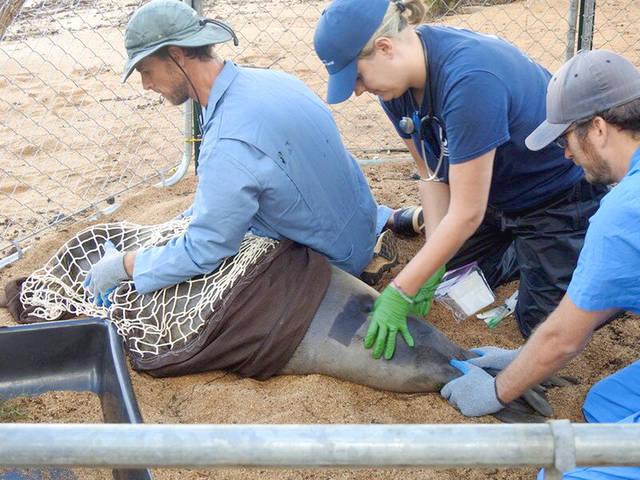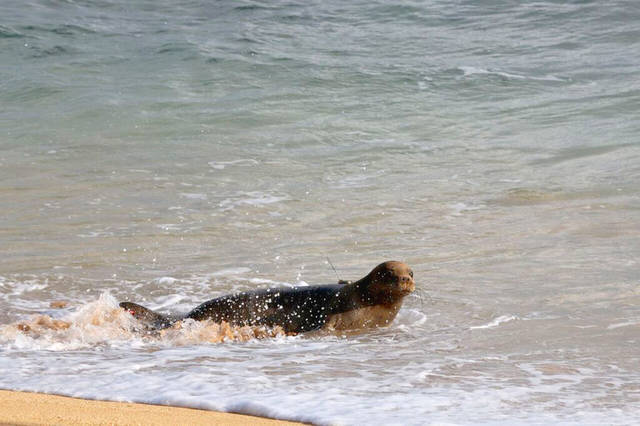LIHUE — The son of popular Hawaiian monk seal “Rocky” has returned to Kauai after a nearly six-month stay at the monk seal hospital on Hawaii Island.
The male pup RK58 was born on July 16, 2018 to monk seal RH58, or Rocky — a seal born in 2000. She’s been pupping on Kauai’s remote north shores for years, but her 10th pup was born on the crowded Waikiki shoreline in June 2017.
That spurred RH58 to stardom and set the spotlight on her for the 2018 pupping season.
She gave birth to RK58 in her usual style, on Kauai’s remote beaches, but threw in a twist when she was involved in a mom-pup switch-up with another pair on the same beach.
Officials with the Ke Kai Ola, The Marine Mammal Center’s hospital and visitor center, say volunteers who were monitoring the pup noticed about five days after his birth, RK58 had switched moms.
After the switch-up, RK58 was reunited with Rocky, who initially accepted him. About a week later, that turned to rejection. So malnourished and without a mom, officials sent RK58 to the monk seal hospital for rehabilitation.
He’s the youngest monk seal to be rehabilitated at Ke Kai Ola.
“RK58 was a challenging case, and it was clear after months of rehabilitative work that he would not have survived on his own in the wild,” says Dr. Claire Simeone, hospital director at Ke Kai Ola. “We are thrilled that he has learned the skills he needs to successfully forage, and that he has a second chance at life back on Kauai.”
Pup switches are a natural occurrence that are observed annually in the Northwestern Hawaiian Islands, but are less common in the main Hawaiian Islands due to the lower density of moms and pups, according to The Marine Mammal Center.
Earlier in 2018, experts from The Marine Mammal Center and the National Oceanic and Atmospheric Administration successfully rehabilitated Sole, a young male pup born on Molokai who was also involved in a mom-pup pair switch, the first time a rescue effort was made in response to this behavior in the main Hawaiian Islands.
“As we do with all our monk seal moms and pups, we worked hard to ensure Rocky had a successful nursing period. We did everything we could to keep Rocky and her pup together, but despite our best efforts, Rocky stopped nursing her pup and we had to intervene to save the pup’s life,” says Jamie Thompton, the Kauai Marine Mammal Response Program coordinator with NOAA’s National Marine Fisheries Service. “However, we are fortunate that the Hawaiian monk seal hospital Ke Kai Ola is prepared to accept orphaned pups like RK58.”
At the hospital, RK58 learned how to eat fish on his own and nearly doubled his weight by the time Simeone and her team cleared him for release back to his birthplace on Kauai.
Simeone also accompanied RK58 on his trip back to Kauai. In order to ensure that he had acclimated back to his environment, RK58 was monitored in a beach pen for two days before being released on that same remote Kauai beach. The seal will be monitored by volunteers in the Kauai Marine Mammal Response Network, and a satellite tag has been placed to track RK58’s movement and ensure he is thriving in the wild.
The Marine Mammal Center, NOAA’s Pacific Islands Fisheries Science Center, state Department of Land and Natural Resources, and Kauai Marine Mammal Response Network volunteers all contributed to RK58’s transport and release.
“This was an excellent example of the public-private partnerships needed for conservation success,” Simeone said. “Conservation takes a village, and endangered Hawaiian monk seals benefit when our communities are inspired to contribute in such an impactful way.”
The Marine Mammal Center has rehabilitated 27 monk seals since opening Ke Kai Ola in 2014, the majority of which were rescued from the Northwestern Hawaiian Islands.
•••
Jessica Else, environment reporter, can be reached at 245-0452 or jelse@thegardenisland.com.






There goes another 900 pounds of reef fish per month around the island. Catering to, and nurturing these seals are the worst thing that couldve happened to kauai’s shores.
Wowlaulau, the estimate is inaccurate. A seal that size might eat 4-6 lbs a day maybe. So about 1/5 of your estimate. A lot of foraging isn’t on reef but crosses a variety of habitats from shallow reef to subphotic depths. The daily consumption of all monk seals combined doesn’t even come close to what is extracted by other top predators sharks and ulua etc each day…and much much less than human extraction every day. So it is all relative. The real threats to marine food resources and biomass on reefs in Hawaii aren’t seals but degradation to reefs due to climate change, runoff from terrestrial development, and over-harvesting in some areas by humans. Monk seals can be troublesome for some people when they are fishing, but blaming seals for loss of fish biomass is chasing the wrong culprits and leaves are oceans at risk.